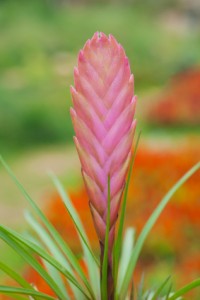Exploring the Tillandsia Bromeliad
Author: Celeste Booth8 Comments
Tillandsia (pronounced “til land see ah”) is a genus of plant found in the Bromeliad family. There are over 500 different species of Tillandsia, and while they have many common characteristics, they also vary greatly in range, size and needs. They are found throughout southern North America, Central America and South America. One of the most common and familiar species of Tillandsia found growing naturally through much of the southern United States is Spanish Moss.
Tillandsia are referred to as air plants because of the unique way they grow. Most are epiphytes meaning they grow attached to other plants, such as trees. They are not parasitic as they gather all of their own nutrients and water and cause no harm to their host plants. Spanish Moss exemplifies the name air plants as you can see it dangling from telephone wires and tree branches.
While Tillandsia can be a fun addition to a terrarium or any bromeliad collection both indoors or outdoors, it is important to understand how they grow in order to best provide for their needs and help them thrive.
How Tillandsia Grow

Spanish Moss
Tillandsia grow attached to other surfaces. A few can be grown in a pot or in the ground, but typically they grow best mounted on another structure. Most plants in other genera have roots that take up water and nutrients from the soil. On a Tillandsia, roots are primarily used as support. The roots attach themselves to the host plant or mount and instead of taking up moisture and nutrients from the ground they absorb them from the air hence the name “air plants”. They have small protrusions on their leaves that do the job of taking in moisture and nutrients. These structures are called trichomes. In their natural habitat the plant takes in water that comes from rain and dew. They cannot survive on humidity alone.
Like most bromeliads Tillandsia only flower once. Often before they flower some of the leaves, called bracts, may turn a bright color such as pink or red. A bromeliad flower will usually last for a long time, but after the flower is spent the plant will die. Before the plants dies it will produce offspring called pups. These pups can be separated from the mother plant and grown individually.
Growing Needs
Needs for light, temperature and water can vary greatly between species of Tillandsia. Some are more adapted to arid climates while others prefer humid environments. None are frost tolerant, but many will tolerate high temperatures. Before attempting to grow a Tillandsia find a species that fits your growing environment well. There are a few questions you can ask yourself; do you want to place them in a humid terrarium? Do you want to grow them in your dry, heated home? How much light do I have available? These questions will help you find a Tillandsia that will fit your growing capabilities.
Water
A general rule is that plants with thin leaves thrive in rainy or humid areas while plants with thick leaves thrive in drier climates. It very significant to the plant’s health that once mounted your Tillandsia receives enough water. It is a misconception that misting your plant will provide enough water to survive. While many Tillandsias are very drought tolerant they will go dormant and not thrive if they are not watered properly. To water your plant you can soak it thoroughly with a hose or run it under the kitchen sink for a few minutes. If your plant is suffering from severe dehydration you can soak it for up to twelve hours to revive it. It is wise to water your plant two to three times a week. The Bromeliad Society International also discusses the much debated time of day (night or morning) best for watering Tillandsias. Unlike many other plants Tillandsias take up carbon dioxide at night. Most plants open their stomata on their leaves to gather carbon dioxide during the day. The process of photosynthesis uses sunlight to change carbon dioxide into energy. However, this can result in a loss of precious amounts of water. In order to avoid this loss of water Tillandsias have adapted to open their stomata at night to prevent evaporation during daylight heat. If the plant is watered in the evening or at night it will not have time to dry before the stomata open. The water will block the stomata and over time cause the plant to suffocate. Therefore, the best time of day to water a Tillandsia is in the early morning. This will give the plants plenty of time to dry out before they increase their intake of carbon dioxide. If you choose to put your Tillandsia in a terrarium make sure there is sufficient airflow so that the plant will not constantly remain wet. The plant must dry out between waterings or it can both suffocate and rot.
Mounting

Tillandsia Cyania
Tillandsias can be mounted to any number of surfaces; wood, cork bark, seashells and rocks are a few good examples. Rough surfaces work particularly well. Any waterproof glue such as plumbers glue can be used as well as wire or even staples to attach the plant to the host surface. Hot glue can be used, but because water causes hot glue to break down it will need to be replaced eventually. Do not use anything that has copper in it for a mount or attachment such as treated wood or wire. Copper can cause significant damage to bromeliads. You can cut away roots that are in the way of a proper mount without cause any damage. However, be careful not to cut or staple through any living tissue. This will cause permanent damage to the plant. Tillandsias can even be placed on rocks in a pot. However, be careful when you are watering a plant mounted this way because the roots must not stay wet. If they sit in water they will rot causing damage to the whole plant.
Light
An office is an excellent plant for Tillandsias. Because of their size they can be perfect for a desk or even to hang on a cubicle. And florescent lighting in an office space will provide enough light for the plant to grow. In your home a Tillandsia will do well in indirect sunlight. The plant will enjoy a lot of light. However, too much direct sun, such as a south facing window, can burn the plant and cause damage to the leaves. Outdoors a light shady space under a tree for example is a good spot for a Tillandsia.
With the number of beautiful, unique species and the versatility in methods for mounting there is no limit to what you can create with Tillandsia plants. They are a fun addition to any collection and can be easy to care for when you follow a few simple rules. Always water your plants thoroughly do not let them sit in water for long periods of time and provide adequate amounts of light.
Sources
Flower, Andrew. Vampires, Tillandsias… Things That Go Suck In The Night. Bromeliad Society International. <http://www.bsi.org/brom_info/growing/cam.html>
Air Plants -Tillandsia <http://plants.web-indexes.com/airplants/index.html>
Bromeliad Society/ Houston. <http://bromeliadsocietyhouston.org/genera-intro/tillandsia/>
Tillandsia. Wikipedia <http://en.wikipedia.org/wiki/Tillandsia>
8 Responses to “Exploring the Tillandsia Bromeliad”
Leave a Reply

Resource Download
Hechtia Care Cheat Sheet
Learn how to care for your Hechtia bromeliad with this quick and easy informational guide.
Learn More
Ask an Expert
Questions about bromeliads?
Our experts love a challenge!
Photo of the Week
Submit your photo to be featured on the blog!
More Photo of the Week Winners
Submit Photo








How do you separate them to plant them?
I know I was wondering the same thing
Our customers love these. We have some small blooming ones that are beautiful!!!!
My beautiful flower was Somehow broken off 🙁 will another flower grow ? It was a gift. I am not a plant person but love this plant. The flower seemed to be The plant itself with many leaves of course. I hope im making sense. I wabt my flower back
Most bromeliads will only flower once on their lifetime. Here is a small article titled, Will My Bromeliad Bloom Again? that explains bromeliad blooming and propagation:
PLEASE HELP (TRULY DESPERATE) I MAY sound like a wierdo but my harrissii tilly was recently attacked, by my dachshund! I though he had only bit one of the thick leAves but, then i found a puncture through the trunk/ stem. It did not go all the way through ( maybe 1/2 way). I currently have it wrap in gauze. Any input., or suggestions? (GREATLY appreciated!)
Thank you in advance,
Jess (westminster, Md)
hey bro ur plnet ok?
it´s great